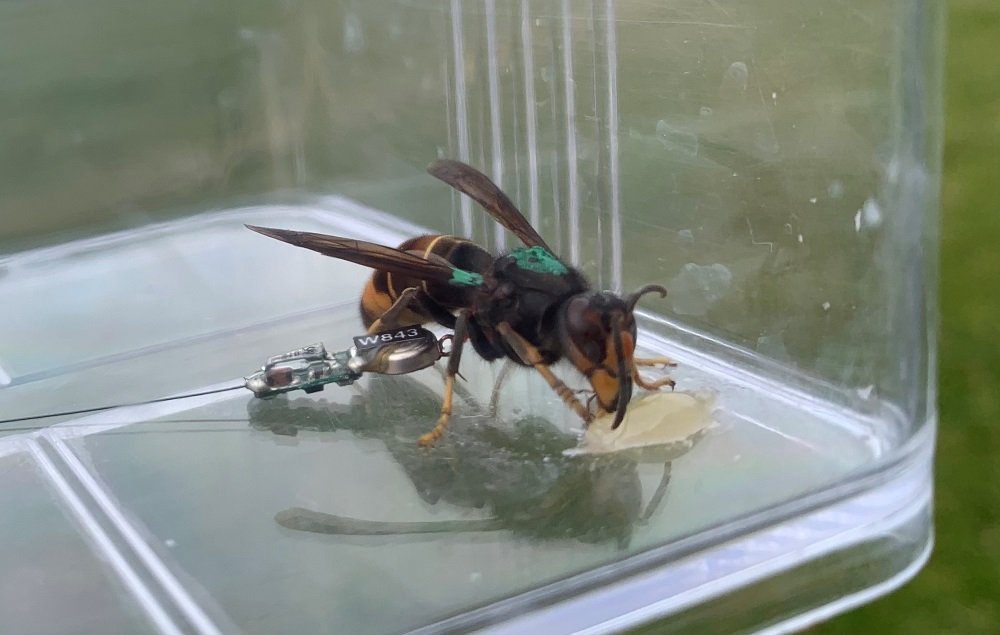The Asian Hornets commonly referred to as the “yellow-legged hornet” because of the color of its tarsi, is a formidable predator of honey bees and other significant pollinators.

The Asian Hornets (Vespa velutina), commonly referred to as the “yellow-legged hornet” because of the color of its tarsi, is a formidable predator of honey bees and other significant pollinators. Although the bug is native to South East Asia, it has been spotted in several locations in Central and Southern Europe over the past 20 years.
The EU has listed the yellow-legged hornet as one of its top ten most dangerous invasive alien species. It has been challenging to stop its spread. However, communities may be able to find and eliminate Asian hornet nests with the aid of a possibly revolutionary strategy pioneered by CABI scientists in Switzerland.
Plant pots brought from eastern China are thought to be responsible for the accidental introduction of the Asian hornet to Europe. The species has swiftly spread throughout the continent since the first findings were made in south-western France in 2004. Cases have been reported in Spain, Portugal, Italy, Germany, Belgium, Luxemburg, Switzerland, the Netherlands, and the United Kingdom.
The Asian hornet doesn’t behave much more aggressively toward humans than its European equivalent, so there isn’t much of a risk to people right away, but the venom from both its sting and its bites can trigger life-threatening allergic responses. Due to its eating habits, this species poses a higher, more long-term danger to food security and biodiversity.
Bumblebees, hoverflies, and halictids are just a few of the significant pollinators that the yellow-legged hornet preys on. But what has raised the most concern is that the Asian hornet is a specialized predator of the European honey bee (Apis mellifera).
Over 80% of the crops and wild plants on the continent are pollinated by pollinators, notably honey bees, who bring in an estimated €22 billion annually to the European agricultural sector.
By hovering in front of hives and killing workers as they enter and exit, the Asian hornet kills honey bees. Honey bees may protect themselves from intruders who are hostile by using heat-balling. There is some proof that the Asian, or Eastern, honey bee (Apis cerana) is more effective at utilizing this tactic against yellow-legged hornets than the European honey bee (Apis mellifera).
The European hornet (Vespa crabro), the gigantic Asian hornet (Vespa mandarinia), and the southern giant hornet (Vespa soror) are all larger than the yellow-legged hornet. However, because of its agility and speed, Vespa velutina has been shown by researchers to be more successful in capturing its prey than other hornet species.
According to research, the annual economic cost of losing bee colonies in France might reach €30.8 million. In France, Italy, and the UK, the yearly expense of attempting to stop the spread of Asian hornets might total €11.9 million, €9.0 million, and €8.6 million, respectively.
From cities to woodlands, Asian hornets may survive in a range of settings. Since the initial reports in France, efforts have been made to slow the spread of the disease throughout Europe. The European honey buzzard, which eats wasp and hornet larvae, has been suggested by some to be a useful tool in the fight against the expansion of the Asian hornet.
As of now, eliminating the nests is the only strategy that has been shown to decrease the spread and lessen environmental effects. However, detecting nests before hornet populations increase is not as simple as it may appear.
Asian hornet populations construct two nests year. The spring is when the queens come out of hibernation and build their major nests. Workers construct supplementary nests when the original nests have reached an appropriate size.
Hornets construct secondary nests amid the foliage or high in tree canopies, which makes them frequently difficult to locate. Because of their papery appearance, the nests are hard to tell apart from leaves and branches.
The majority of hornet nests are found in the late fall after the trees have lost their foliage. By then, the subsequent generation of queens has given birth and is getting ready to hibernate for the winter. Around April, the nesting cycle starts up again. Asian hornets have the ability to continuously increase their range by 100 kilometers every year.
A CABI research that started in Switzerland in 2017 focused at tracking the yellow-legged hornet’s expansion. Along the Swiss-French border, in the canton of Jura, the species was originally discovered. Since then, it has extended deeper into Swiss territory.
In the Jura, the project team set up a long-term observation system in 2017. The goal was to ascertain how the invading hornet will affect the European hornet and several wasp species. To assess where in Switzerland the hornets may establish nests, the scientists created and applied climatic models.
Dr. Lukas Seehausen, the project’s principal investigator, used radio telemetry to effectively detect Asian hornet nests in 2020 and 2022. By placing small radio tags on hornets collected in front of bee hives, he was able to locate the nests. This made it possible for Seehausen to locate the hornets’ nesting place. With the aid of experienced tree climbers, Seehausen found the nests and destroyed them to stop their further spread.
An efficient way to find and get rid of Asian hornet nests is by employing this novel radio telemetry strategy. Both local ecosystems and bee populations will benefit from this. The method has enormous potential to manage invasive species and protect biodiversity in the long run.
Currently, Lukas leads training classes on how to use radio telemetry and triangulation to find yellow-legged hornet nests throughout Switzerland and neighboring countries. By assisting more individuals in finding nests, these seminars can lessen the negative effects that this invasive species has on honey bees and other pollinators.